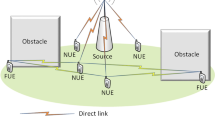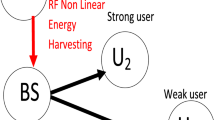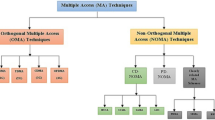Abstract
In this paper we propose two new cooperative relaying schemes which enable distributed implementation of the orthogonal space time block coding (OSTBC) with 3/4 code rate. These proposed schemes are compared with cooperative relaying scheme with virtual OSTBC and 1/2 code rate. The considered schemes are used for creating virtual 4 × 1 multiple input–single output (MISO) channel, and include one base station with two antennas, two relay stations each with a single antenna and one mobile station with a single antenna. Obtained results show that in the case of the same bit rate the proposed schemes provide better bit error rate (BER) performances than virtual OSTBC with 1/2 code rate. On the other side, for the same symbol constellations the proposed schemes have almost identical BER performances as virtual OSTBC with 1/2 code rate, but with a benefit of 1.5 times increased code rate.





Similar content being viewed by others
References
Zanella, A., Bui, N., Castellani, A., Vangelista, L., & Zorzi, M. (2014). Internet of things for smart cities. IEEE Internet of Things Journal, 1(1), 22–32.
Jiong, J., Gubbi, J., Marusic, S., & Palaniswami, M. (2014). An information framework for creating a smart city through internet of things. IEEE Internet of Things Journal, 1(2), 112–121.
Farkas, K., Feher, G., Benczur, A., & Sidlo, C. (2015). Crowdsending based public transport information service in smart cities. IEEE Internet of Things Journal, 53(8), 158–165.
Solanas, A., Patsakis, C., Conti, M., Vlachos, I., Ramos, V., Falcone, F., et al. (2014). Smart health: A context-aware health paradigm within smart cities. IEEE Communications Magazine, 52(8), 74–81.
Qilong, H., Shuang, L., & Hongli, Z. (2015). Mobile cloud sensing, big data, and 5G networks make an intelligent and smart world. IEEE Network, 29(2), 40–45.
Urosevic, U., Veljovic, Z., & Pejanovic-Djurisic, M. (2013). MIMO Solution for performance improvements of OFDM-CDMA system with pilot tone. Wireless Networks, 19(8), 2021–2028.
Paulraj, A. J., & Nabar, R. U. Bolcskei, H. (2004). An overview of MIMO communications—a key to gigabit wireless. Proceedings of the IEEE (Vol. 92(2), pp. 198–218), February 2004.
Boccardi, F., Clerckx, B., Ghosh, A., Hardouin, E., Jöngren, G., Kusume, K., et al. (2012). Multiple-antenna techniques in LTE-advanced. IEEE Communications Magazine, 50(3), 114–121.
Woong, C. (2011). Performance of amplify-and-forward cooperative networks with differential unitary space time coding. Wireless Networks, 17(3), 621–627.
He, C., Sheng, B., Zhu, P., Wang, D., & You, X. (2012). Energy efficiency comparison between distributed and co-located MIMO systems. International Journal of Communication Systems. doi:10.1002/dac.2345.
Wang, D., Wang, J., You, X., Wang, Y., Chen, M., & Hou, X. (2013). Spectral efficiency of distributed MIMO systems. IEEE Journal on Selected Areas in Communications, 31(10), 2112–2127.
Truong, K. T., Sartori, P., & Heath, R. W. (2013). Cooperative algorithms for MIMO amplify-and-forward relay networks. IEEE Transactions on Signal Processing, 61(5), 1272–1287.
Chaofan, M., Wei, L., Meng, Z., & Sharif, H. (2015). A connectivity-aware approximation algorithm for relay node placement in wireless sensor networks. IEEE Sensors Journal, 16(2), 515–528.
Urosevic, U., & Veljovic, Z. (2015). Improving BER performance of virtual QOSTBC. Wireless Networks. doi:10.1007/s11276-015-1128-4.
Veljovic, Z., & Urosevic, U. (2015). Increasing code rate of the cooperative relaying with virtual OSTBC. Wireless Personal Communications, 83(1), 399–410.
Urosevic, U., Veljovic, Z., & Pejanovic-Djurisic, M. (2014). A new solution for simple cooperative relaying. Wireless Personal Communications, 75(2), 1235–1250.
Yamaoka, T., Hara, Y., Fukui, N., Kuboand, H., & Yamazato, T. (2012). A simple cooperative relaying with alamouti coded transmission. IEICE Transactions on Communications, E95–B(2), 643–646.
Kühn, V. (2006). Wireless communications over MIMO channels—Applications to CDMA and multiple antenna systems (pp. 283–288). New Jersey: Wiley.
Tarokh, V., Jafarkhani, H., & Calderbank, A. R. (1999). Space–Time block codes from orthogonal designs. IEEE Transactions on Information Theory, 45(5), 1456–1467.
Suraweera, H. A., Karagiannidis, G. K., & Smith, P. J. (2009). Performance of the dual-hop asymmetric fading channel. IEEE Transactions on Wireless Communications, 8(6), 2783–2788.
Acknowledgments
Work is funded by European Union project Fore-Mont as a part of Seventh Framework Programme (Grant Agreement No. 315970 FP7-REGPOT-CT-2013).
Author information
Authors and Affiliations
Corresponding author
Rights and permissions
About this article
Cite this article
Veljovic, Z., Urosevic, U. New Solutions for Cooperative Relaying Implementation of OSTBC with 3/4 Code Rate. Wireless Pers Commun 92, 51–61 (2017). https://doi.org/10.1007/s11277-016-3838-z
Published:
Issue Date:
DOI: https://doi.org/10.1007/s11277-016-3838-z




